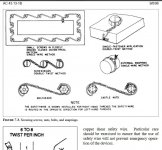And I use self-locking nuts with blue threadlocker (after all, belts are known to fail so you need suspenders).
Another issue (this may be the height of anal-retentiveness): Like with castellated nuts (suspension parts and on the front hub spindles), there is usually a gap between the nut--or, in this case the bolt head and its flange-- and a cotter key that would allow the nut/bolt to rotate ever-so-slightly and relieve some of the stretch tension on the nut/bolt. So, for the driveshaft fasteners (and castellated nuts), before torquing I back the bolt head back so that the edge of the flat is set against the yoke flange in the de-torquing direction, and wedge a flat screwdriver under the gap before torquing it so that the bolt cannot rotate and relieve the tension on the bolt.
It would be possible, working from memory, to drill the bolts and nuts so that safety wiring could be used. The principle is the same: wire the nuts/bolts in such a way they resist loosening:

 Hi Guest!
Hi Guest!

 smilie in place of the real @
smilie in place of the real @
 Pretty Please - add it to our Events forum(s) and add to the calendar! >>
Pretty Please - add it to our Events forum(s) and add to the calendar! >> 

